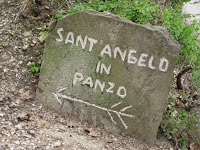Gospel Quote - Matthew 17:20. "Amen, I say to you, if you have faith as tiny as a mustard seed, you will be able to say to this mountain: 'Move from here to there,' and it will move. Nothing will be impossible for you." It's easy to overlook the power of faith, hope and love during challenging times. Alone one may feel helpless, but one need not be alone.
***
Umbrian Adventure - High on the side of Mount Subasio, above the Eremo delle Carceri, rests a hill named Calle San Rufino. Hidden from view of those passing by is a makeshift shrine. The following notes are from visits there over the past several years.The trek back down from the summit included crossing over the top of Colle San Rufino and revisiting an interesting, unmarked location carved into the rocky hillside, that some person or persons years ago transformed into a rough shrine. Here are a few pictures, the first looking down from above.
Next from the side.
Here are some closer pictures, starting with a partial manger scene.
Another manger scene, sheltered by plastic.
Two venerated saints.
A quote (trans: Two things in the world will never abandon you: the eye of God that always sees you, the heart of the Mother that always follows you) and a cross.
Saint Catherine of Siena.
The Basilica of Saint Francis in Assisi.
Here's a closer look at a couple of tiles, the right one including the Canticle of the Creatures in Italian.
Finally, one of many nice messages.
"Who gives, gives to God."
With inspiring views of Subasio above and the valley below, Colle San Rufino is a special place to visit.
***
Reflections - The Gospel quote above brought to mind a story told in Venice. I've written in the past about a lovely girl named Contessa Tagliapietra, who was born in 1288 and died after a long illness in 1308. Her family lived in Campo San Vio, along the Grand Canal. Contessa, whose royal-sounding name was attributed to her family's role in a war with Genoa, was very devout as a child. She would often cross the Grand Canal in a gondola to pray in the Church of San Maurizio, located on the opposite side. As she grew older, her father became concerned that his daughter might be too devout, which could impact the marriage he hoped for her. Unable to dissuade her from her frequent trips to the Church of San Maurizio, he finally instructed all of the nearby gondoliers to refuse to transport her.
The next time that she set out to cross the Grand Canal to pray, every gondolier she approached denied her request for a ride. Finally, she went to the edge of the canal, took a linen cloth and, stretching it out on the water, stepped onto it and floated across.
For centuries Contessa's story has been the subject of studies and debates on miracles and myths, cults and devotions. For a long time Venetian mothers would set their infants over the entombed remains of Contessa, praying for their safety in avoiding drowning in the canals.
Apparently no proof was ever been found of a miracle having occurred.
On the other hand, if Contessa had faith as tiny as a mustard seed....
***
Something Franciscan - Within Assisi's walls there are treasures most visitors never see. First, one would need to know they existed; then, one would need to know if, when and how they might be accessed. One of them is the beautiful small 14th Century Church, or Oratory, of San Vitale, atop a flight of stairs accessed by passing through an often closed wooden door.
Another is the 13th Century Church of Sant'Andrea, under the care of an order of Franciscan nuns. Then, close by the Piazza del Comune, there is the 11th Century Church of San Paolo, maintained by one of Assisi's confraternities, with its art treasures.
Also from the 11th Century is the Church of San Giacomo di Murorupto (Saint James of the Broken Wall - a reference to an old broken wall in the area.) This, too, is under the care of Franciscan nuns, and requires permission to visit.
Francis may well have prayed in the latter two Churches.
Pax et bonum.
Another is the 13th Century Church of Sant'Andrea, under the care of an order of Franciscan nuns. Then, close by the Piazza del Comune, there is the 11th Century Church of San Paolo, maintained by one of Assisi's confraternities, with its art treasures.
Also from the 11th Century is the Church of San Giacomo di Murorupto (Saint James of the Broken Wall - a reference to an old broken wall in the area.) This, too, is under the care of Franciscan nuns, and requires permission to visit.
Francis may well have prayed in the latter two Churches.
Pax et bonum.


















































